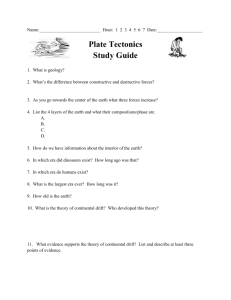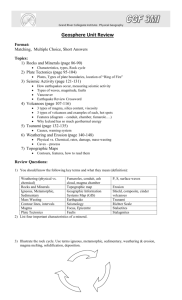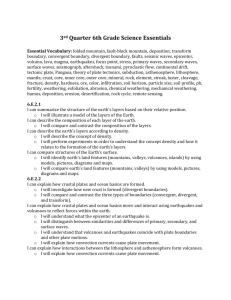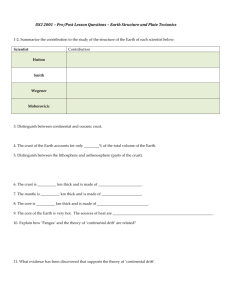Earth Science – Quiz 2
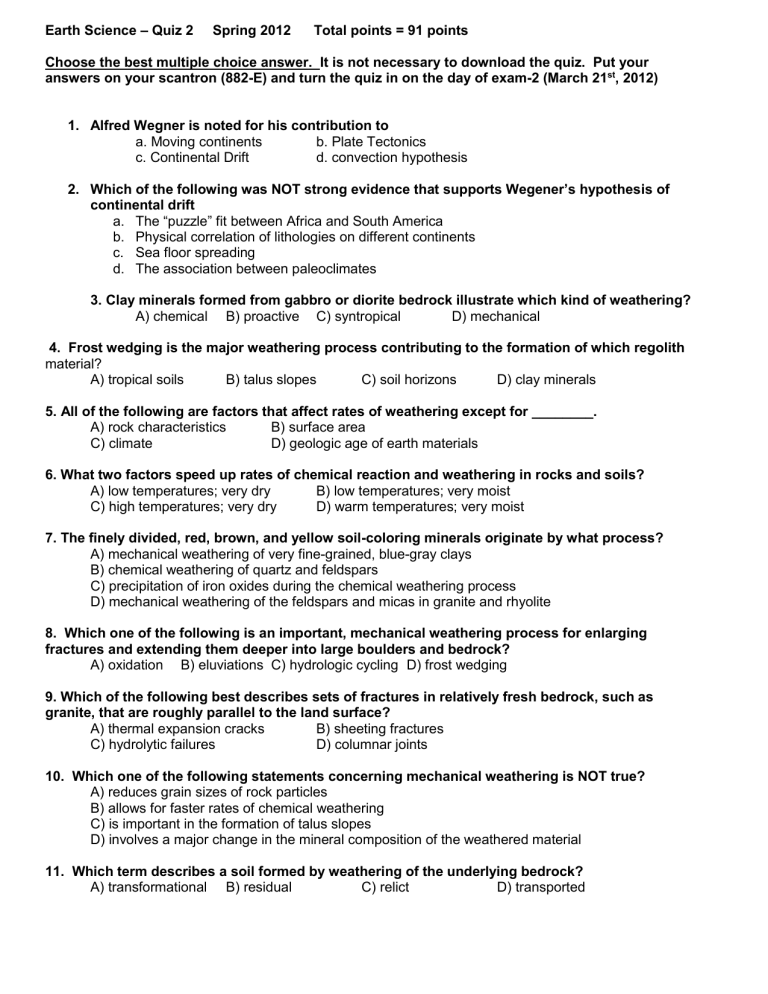
Earth Science – Quiz 2 Spring 2012 Total points = 91 points
Choose the best multiple choice answer. It is not necessary to download the quiz. Put your answers on your scantron (882-E) and turn the quiz in on the day of exam-2 (March 21 st , 2012)
1. Alfred Wegner is noted for his contribution to a.
Moving continents b. Plate Tectonics c. Continental Drift d. convection hypothesis
2. Which of the following was NOT strong evidence that supports Wegener’s hypothesis of continental drift a. The “puzzle” fit between Africa and South America b. Physical correlation of lithologies on different continents c. Sea floor spreading d. The association between paleoclimates
3. Clay minerals formed from gabbro or diorite bedrock illustrate which kind of weathering?
A) chemical B) proactive C) syntropical D) mechanical
4. Frost wedging is the major weathering process contributing to the formation of which regolith material?
A) tropical soils B) talus slopes C) soil horizons D) clay minerals
5. All of the following are factors that affect rates of weathering except for ________.
A) rock characteristics
C) climate
B) surface area
D) geologic age of earth materials
6. What two factors speed up rates of chemical reaction and weathering in rocks and soils?
A) low temperatures; very dry
C) high temperatures; very dry
B) low temperatures; very moist
D) warm temperatures; very moist
7. The finely divided, red, brown, and yellow soil-coloring minerals originate by what process?
A) mechanical weathering of very fine-grained, blue-gray clays
B) chemical weathering of quartz and feldspars
C) precipitation of iron oxides during the chemical weathering process
D) mechanical weathering of the feldspars and micas in granite and rhyolite
8. Which one of the following is an important, mechanical weathering process for enlarging fractures and extending them deeper into large boulders and bedrock?
A) oxidation B) eluviations C) hydrologic cycling D) frost wedging
9. Which of the following best describes sets of fractures in relatively fresh bedrock, such as granite, that are roughly parallel to the land surface?
A) thermal expansion cracks B) sheeting fractures
C) hydrolytic failures D) columnar joints
10. Which one of the following statements concerning mechanical weathering is NOT true?
A) reduces grain sizes of rock particles
B) allows for faster rates of chemical weathering
C) is important in the formation of talus slopes
D) involves a major change in the mineral composition of the weathered material
11. Which term describes a soil formed by weathering of the underlying bedrock?
A) transformational B) residual C) relict D) transported
12. Which one of the following statements best describes erosion?
A) disintegration and decomposition of rocks and minerals at the surface
B) movement of weathered rock and regolith toward the base of a slope
C) the process by which weathered rock and mineral particles are removed from one area and transported elsewhere
D) the combined processes of leaching, eluviation, and mass wasting
13. Which term best describes those processes that move weathered rock materials and soils downslope?
A) podzolization B) slope sheeting C) mass wasting D) talus transfer
14. Assume that water filling a crack in a rock undergoes cycles of freezing and melting. Which of the following statement is true?
A) Water expands as it melts, causing the crack walls to be pushed apart.
B) Water shrinks as it freezes, causing the crack walls to be drawn closer together.
C) Water expands as it freezes, causing the crack walls to be pushed apart.
D) Water shrinks as it melts, causing the crack walls to be pulled closer together.
15. Which of the following best describe the E soil horizon?
A) regolith zone B) erosion zone C) residual zone D) leaching zone
16. In which area would weathering by frost wedging probably be most effective?
A) in a moist, tropical forest
C) where the subsoil is permanently frozen
B) in cool high desert areas
D) in moist, temperate climates
17. From the land surface downward to the unweathered bedrock, which of the following is the correct order of the different soil horizons?
A) 0, A, E, B, C, bedrock
C) E, A, B, C, 0, bedrock
B) A, B, C, D, E, bedrock
D) D, E, C, B, A, bedrock
18. ________ denotes the exposed, crescent-shaped rupture surface at the head of a slump.
A) Scoop B) Sole C) Toe D) Scarp
19. Consider a weathered rock or soil particle lying on a slope. How will the gravitational force pulling the particle downward along the land surface vary with the inclination of the slope?
A) It will increase as the slope angle is lessened.
B) It will decrease as the slope angle is lessened.
C) It is not affected by the slope angle.
D) It will possibly increase or decrease as slope angle is lessened, depending upon other factors.
20. How do the strength and cohesion of clay-rich regolith or soil change with the addition of water?
A) Water does not affect the cohesion but lowers the strength.
B) Water reduces the strength of clays but raises the cohesion of the soil.
C) Water increases the strength and cohesion.
D) Water lowers the strength and cohesion.
21. ________ involves movement on a zone of compressed air.
A) A slump B) A mudflow C) A rock avalanche D) Soil creep
22. Of the following, which one would most likely be triggered by an earthquake?
A) solifluction B) soil creep C) slump D) rock avalanche
23. Which statement best describes slumping, a mass wasting process?
A) a block or blocks of unconsolidated regolith slide downhill along a curved slip surface
B) blocks of hard bedrock rapidly slide downhill along fracture surfaces
C) the soil and regolith move downhill very slowly
D) a mass of soil or regolith becomes saturated with water and suddenly flows downhill to the base of the slope
24. Which mass wasting process has the slowest rate of movement?
A) slump B) rock avalanche C) rock fall D) creep
25. All of the following are factors affecting mass wasting except for ________.
A) gravity B) water C) slope angle D) geologic age
26. The most rapid type of mass movement is a ________.
A) slump B) lahar C) rock avalanche D) debris flow
27. As an erosional process, how is mass wasting unique from wind, water, and ice?
A) Mass wasting affects particles of all sizes whereas the others affect only smaller particles.
B) Mass wasting does not require a transporting medium.
C) Mass wasting affects much larger geographic areas than does wind, water, and ice.
D) All of the above make mass wasting unique compared to wind, water, and ice.
28. Which of the following mass movements is most likely to occur in a geologic setting where the rock strata are inclined?
A) debris flow B) slump C) creep D) rockslide
29. How do freezing, thawing, wetting, and drying contribute to soil creep?
A) The soil becomes much weaker when dry and frozen.
B) Gravity exerts a much stronger force when the soil is wet and thawed.
C) The soil expands and contracts, lifting particles and dropping them a slight distance downslope.
D) Eventually, these cause the soil and regolith to suddenly slide down the slope.
30. All of the following are possible indicators that creep is occurring except for ________.
A) tilted fences or power line poles B) an extremely thick soil profile
C) curved tree trunks D) cracks in roads or sidewalks
31. The general process by which rock, soil, or unconsolidated material moves downhill is called ____ a. solifluction c. liquefaction b. mass movement d. plate tectonics
32. The characteristic slope of a pile of dry sand is called the ________ a. angle of repose b. strike c. consolidation factor
33. How do geologists classify mass movements? a. by the speed of the mass movement b. by the nature of material c. by the nature of the movement d. all of these d. dip
34. Which of the following mass movements is the fastest? a. mudflow b. debris avalanche c. soil creep d. earthflow
35. Which of the following is the most important factor in causing mass movements? a. temperature b. pressure c. water content d. composition
36. Chemical weathering is sped up by acids. The most common natural acid on the Earth’s surface is _____ a. nitric acid b. hydrochloric acid c. carbonic acid d. sulfuric acid
37. Which of the following is NOT an example of chemical weathering? a. dissolution of calcite b. breakdown of feldspar to form kaolinite c. splitting of a rock d. rusting a nail
38. Water seeping into rock fractures and then freezing causing rocks to break is known as a. exfoliation b. frost wedging c. ice breaking d. cryo-fracturing
39. Under dominant chemical weathering conditions, which rock would most likely weather faster a. granite b. marble c. sandstone d. Quartzite
40. The strongest evidence that supports the birth of Plate Tectonics is a. the logical connection between South America and Africa b. The union between continental shelves as opposed to continental shorelines c. The overwhelming evidence of fossils that can’t swim across seas d. The mapping of the sea floor and geological activity that takes place
41. The lithosphere is composed of a. both oceanic crust and sea floor b. both continental crust and continental shelf material c. both continental crust and plate material d. both continental crust and oceanic crust
42. P-waves will travel through a . liquids only b. solids only c. the surface d. liquids and solids
43. The elastic rebound theory states: a. rocks will bend and fold due to maximum stresses b. bending of lithospheric plates results in mountains and earthquakes c. how far a rubber band will stretch d. rocks undergo various amounts of strain from stresses and “snap” in response to gain equilibrium
44. The Mercalli scale is known for measuring an earthquakes a . intensity b. energy release c. wave vibrations d. motion
45. The San Andreas fault is a classic example of a. One plate diving beneath another b. One plate sliding past another plate c. One plate separating from another plate d. One plate converging into another
46. The process of convection is defined by a. the upwelling of gasses through solid material b. heat transfer through a solid c. the rising and cooling of liquid material creating circular motions d. heat transfer within the rocks
47. ________ was an ancient reptile that lived in South America and Africa during the late
Paleozoic.
A) Granopteris B) Monastarious C) Glossopteris D) Mesosaurus
48. In the early part of the twentieth century, ________ argued forcefully for continental drift.
A) Karl Wagner B) Jack Pierce C) Alfred Wegener D) Bill Kohl
49. The former late Paleozoic supercontinent is known as ________.
A) Pandomonia B) Pancakea C) Pangaea D) Panatopia
50. The ________ is an example of an active, continent-continent collision.
A) Arabian Peninsula slamming into North Africa under the Red Sea
B) westward movement of the South American plate over the Nazca plate
C) northern movement of Baja California and a sliver of western California toward the Hawaiian
Islands
D) northward movement of India into Eurasia
51. Pull-apart rift zones are generally associated with a ________ plate boundary.
A) transform B) divergent C) convergent D) all plate boundaries
52. Linear, magnetic patterns associated with mid-ocean ridges are configured as ________.
A) concentric circles about a rising plume of hot mantle rocks and magma
B) reversed magnetizations along the rift valleys and normal magnetizations along the ridge
C) normal and reversed magnetized strips roughly parallel to the ridge
D) normal and reversed magnetized strips roughly perpendicular to the ridge axis
53. A typical rate of seafloor spreading in the Atlantic Ocean is ________.
A) 2 feet per year B) 0.1 inches per year C) 20 feet per year D) 2 centimeters per year
54. Which of the following energy sources is thought to drive the lateral motions of Earth's lithospheric plates?
A) gravitational attractive forces of the Sun and Moon
B) electrical and magnetic fields localized in the inner core
C) export of heat from deep in the mantle to the top of the asthenosphere
D) swirling movements of the molten iron particles in the outer core
55. Which of the following statements apply to the asthenosphere, but not the lithosphere?
A) zone in the upper mantle that deforms by plastic flowage
B) cool, rigid layer of crust and upper mantle that forms the tectonic plates
C) deforms mainly by brittle fracturing and faulting
D) partial melting of rising granitic plumes produces huge volumes of basaltic magma
56. New oceanic crust and lithosphere are formed at ________.
A) divergent boundaries by submarine eruptions and intrusions of rhyolitic magma
B) convergent boundaries by submarine eruptions and intrusions of rhyolitic magma
C) divergent boundaries by submarine eruptions and intrusions of basaltic magma
D) convergent boundaries by submarine eruptions and intrusions of basaltic magma
57. Cooler, older, oceanic lithosphere sinks into the mantle at ________.
A) subduction zones along convergent plate boundaries
B) transform fault zones along divergent plate boundaries
C) rift zones along mid-ocean ridges
D) sites of long-lived, hot spot volcanism in the ocean basins
58. Deep ocean trenches are surficial evidence for ________.
A) rifting beneath a continental plate and the beginning of continental drift
B) sinking of oceanic lithosphere into the mantle at a subduction zone
C) rising of hot asthenosphere from deep in the mantle
D) transform faulting between an oceanic plate and a continental plate
59. A transform plate boundary is characterized by ________.
A) stratovolcanoes on the edge of a plate and shield volcanoes on the adjacent plate
B) two converging oceanic plates meeting head-on and piling up into a mid-ocean ridge
C) a divergent boundary where the continental plate changes to an oceanic plate
D) a deep, vertical fault along which two plates slide past one another in opposite directions
60. Which one of the following is an important fundamental assumption underlying the plate tectonic theory?
A) Earth's magnetic field originates in the outer core.
B) Earth's surface area has been essentially constant over time.
C) Radioactive decay slows down at the extreme pressures of the inner core.
D) Earth's ocean basins are very old and stable features.
61. The modern-day Red Sea is explained by plate tectonics theory because it is ________.
A) a tiny remnant of a once immense ocean that was closed as Africa moved toward Asia
B) the site of a transform fault along which Arabia is moving away from Africa
C) a rift zone that may eventually open into a major ocean if Arabia and Africa continue to separate
D) a rare example of a two-continent subduction zone where the African continental plate is sinking under the Arabian continental plate
62. The volcanoes and deep valleys of east Africa are related to a ________.
A) continental rift along which parts of the African continent are beginning to slowly separate
B) fault allowing Arabia to slip westward past east Africa and penetrate into Turkey
C) transform fault aligned with the Red Sea carrying the Arabian and African blocks in opposite directions
D) continental collision zone between Africa and the Zagros Mountains along the southern margin of Eurasia
63. The Aleutian Islands occur at a ________.
A) convergent boundary on a volcanic arc above a northward-subducting Pacific plate
B) transform boundary where North America has moved towards Alaska
C) divergent boundary where shield volcanoes are forming
D) convergent, continental margin with uplifted fault blocks, much like those of the Basin and
64. Early results of the Deep Sea Drilling Project clearly justified the conclusion that ________.
A) the oceans have not always contained most of Earth's water
B) the ocean basins are relatively young; no seafloor with an age in excess of 180 million years was ever found
C) Proterozoic rocks are found only as seamounts in the deepest parts of the ocean basins
D) the youngest sediments were deposited directly on the oldest seafloor basalts
65. The elastic rebound theory for the origin of earthquakes was first proposed by ________ following the ________ earthquake.
A) Reid; 1906, San Francisco
C) Richter; 1989, Loma Prieta
B) Giuseppe; 1925, Pizza Lake
D) Mohorovicic; 1964, Anchorage
66. When an earthquake occurs, energy radiates in all directions from its source. The source is also referred to as the ________.
A) inertial point B) epicenter C) focus
67. Which one of the following statements is correct?
D) seismic zone
A) P waves travel through solids; S waves do not.
B) P and S waves travel through liquids, but P waves do not travel through solids.
C) S waves travel through solids and P waves travel through liquids.
D) P and S waves travel through liquids, but S waves do not travel through solids.
68. ________ have the highest velocities.
A) Primary waves B) Secondary waves C) Surface waves D) Refracted S waves
69. Which one of the following is true regarding tsunamis?
A) They travel as deep-water waves at speeds greater than surface seismic waves but slower than
S waves.
B) Their wave heights decrease and wavelengths increase as they move into shallower water.
C) They are started by fault-induced, horizontal shifts in the seafloor that suddenly propel great masses of water in opposite directions.
D) They occur in the open ocean, wavelengths are many miles or kilometers and wave heights are only a few feet.
70. Major earthquakes are often followed by somewhat smaller events known as ________.
A) aftershocks B) foreshocks C) tremors D) hyposhocks
71. The ________ magnitude scale is a measure of the energy released. It does not directly measure the extent of building damage.
A) Gutenberg B) Reid C) Mercalli D) Richter
72. The instrument that records earthquake waves is termed a ________.
A) polygraph B) thermograph C) seismograph D) barograph
73. ________ is the maximum possible damage designation on the Mercalli scale.
A) XII B) 3 C) X D) 10
74. The position on Earth's surface directly above the earthquake source is called the ________.
A) epicenter B) inertial point C) focus D) seismic zone
75. The mechanism by which rocks store and eventually release energy in the form of an earthquake is termed ________.
A) elastic rebound B) seismic rebound C) fault displacement D) stress fracture
76. Approximately how much more energy is released in a 6.5 Richter magnitude earthquake than in one with magnitude 5.5?
A) 3000 times
77. P waves ________.
B) 3 times C) 300 times D) 30 times
A) propagate only in solids
C) have higher amplitudes than do S waves
78. The Mercalli Scale is a scale from ________.
B) are faster than S waves and surface waves
D) produce the strongest ground shaking
A) 1 to 12 that rates the energy required for faulting to occur
B) 1 to 10 that rates the energy released by an earthquake
C) I to XII that rates the structural damage due to an earthquake
D) I to X that rates the total energy released during the main quake and all aftershocks
79. Most of our knowledge about Earth's interior comes from ________.
A) drill holes B) volcanic eruptions C) seismic waves D) examination of deep mine shafts
80. Which one of the following statements about the crust is NOT true?
A) It is the thinnest of the major subdivisions.
B) It is thickest where prominent mountains exist.
C) Oceanic crust is enriched in potassium, sodium, and silicon.
D) Continental rocks are compositionally different than oceanic rocks.
Identify the following earthquake terminology in the diagram below
81 82
83
84
81.
82. a. focus a. focus
83. a. focus
84.
a. focus b. epicenter c. seismic waves b. epicenter c. seismic waves b. epicenter b. epicenter
85. The Rayleigh wave c. seismic waves c. seismic waves d. fault d. fault d. fault d. fault a. motion similar to an ocean wave b. travels along the surface exhibiting horizontal motion c. motion that travels along the surface producing a “rolling” effect d. is a compressional wave compressing and expanding rock material
86. An earthquake measuring 6.3 on the Richter scale is ____________ times more powerful than an earthquake measuring 4.3 on the Richter scale. a. 10 b. 100 c. 20 d. 1000
87. There are about 600,000 earthquakes annually that range in magnitude a. Greater than M8 b. less than M2 c. M4 to M5 d. M3
88. A Mercalli intensity earthquake of roman numeral 2 would indicate a. A major earthquake b. a very lightly felt EQ c. major damage
89. Which of the following correctly lists the order in which seismic waves arrive at the seismograph station a. P waves surface waves S waves b. S waves P waves Surface waves c. P waves S waves Surface waves d. Surface waves P waves S waves
90. Which of the following has been used, with some success, to make long-term predictions about the location of future large earthquakes? a. the seismic gap method b. the principle of cross cutting relations c. the elastic rebound theory d. all of these
91. Which of the following describes the build-up and release of stress during an earthquake? a. Mercalli Scale c. principle of superposition b. elastic rebound theory d. the seismic gap method


